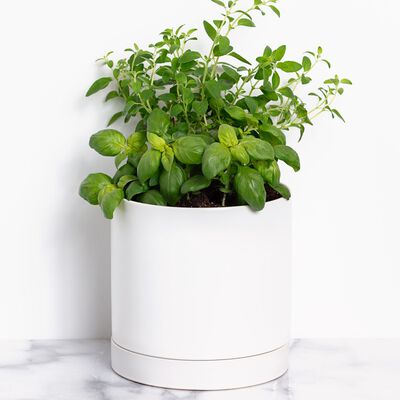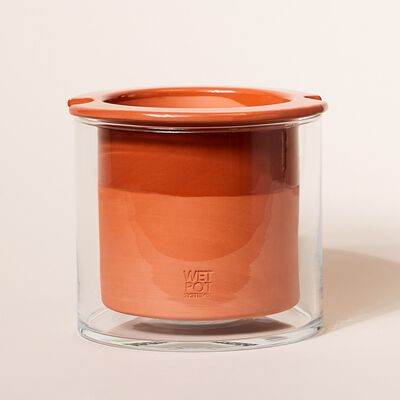
Easy Edibles to Grow in Pots
Turn your patio, deck, balcony, or yard into a petite, perfect garden.
When you think of a vegetable garden, you might envision long, neat rows of tomatoes, peppers, squash, and eggplants—but you don’t need a lot of land to grow fresh produce. Actually, you don’t need any. There are plenty of easy-to-grow edibles that are ideal plants for containers, allowing you to turn your patio, deck, balcony (or, yes, the yard, if you have one) into a petite, perfect garden.
Master The Basics
Let’s start with from the beginning. When shopping for starter plants, resist the temptation to reach for the tallest ones. Instead, seek out sturdy, stocky plants that look well-cared for. Pass on the plants that are already flowering, too—at their young age, they should be concentrating all their strength on growing, not producing.
Containers
Next, of course, you’ll need some containers. Select ones that are roomy enough for the plants you’d like to grow (see our guidelines below) and that match your style personality—there’s a glorious world of glazed ceramic, metal, fiberglass, resin, and plastic options out there. If you’re cultivating a warm, Southwestern aesthetic, terracotta pots may be just what you’re looking for, but know this: They’re porous and absorbent, meaning you’ll really need to keep on top of the watering. Whichever pots you fall in love with, make sure each has at least one drainage hole in the bottom (and sure, you can put one there yourself if you’re handy).

Soil
Fill those containers with a high-quality potting mix—one that contains nutrient-rich compost and a dose of plant food. Successful gardens just don’t happen without great soil, so you don’t want to skimp on this.
Lighting
Most edible plants need lots of sunlight—think 6 hours or more every day (again, more on that below). But here’s the good news: Containers are mobile! So, if you discover your garden needs more sun, you can simply shift the pots to another spot. That mobility also allows you to bring your plants indoors on those nights when chilly temps are in the forecast.
Watering
Now, let’s talk about watering. Because container mix tends to dry out more quickly than in-ground soil, be sure to check on your plants in pots every day and water whenever the top inch of soil is dry. Keep an even closer eye on small pots, which need more frequent watering than larger ones, and of course, those quick-drying terracotta pots.
Maintenance
Finally, remember that your plants need to eat, just like you do. Starting about a month after you plant, feed them regularly with an organic fertilizer created especially for fruits and vegetables. Add it to your watering can every week or two, following the directions on the label.
With the basics out of the way, here are some of the easiest fruits, vegetables, and herbs to grow in pots, plus a few quick tips to help you grow them.

Easy Fruits & Vegetables to Grow in Pots
1. Strawberries
Pot size: At least 10” wide and 8” deep
Good to know:
- Pot strawberry plants so that the spot where the stems meet the roots (called the crown) sits just above the soil surface. Pat down the soil and water well, then put the container where it will get at least 8 hours of daily sun.
- When berries begin to appear, cover plants with netting to keep birds, squirrels, and insects from swiping your harvest.
- Potted strawberries will come back every year but you’ll need to move them into the garage or cellar in the fall if you live in the North. Bring them back out the following spring.
2. Bush Beans
Pot size: At least 10” wide and 6” deep
Good to know:
- Bush beans are shrubby plants that don’t usually need much support, but if they start to flop over, tie them loosely to a bamboo stake.
- Place beans where they get at least 6 to 8 hours of daily sunlight.
- Beans are thirsty plants, so you may need to check them twice a day during hot, dry spells.
3. Bush Tomatoes
Pot size: At least 15” wide and able to hold 5+ gallons of soil
Good to know:
- Bush or “dwarf” tomatoes are compact and don’t need to be staked—in other words, they’re perfect for pots. The fruits all ripen within a month or two of each other, so you can use the container for something else when you’ve picked the last one.
- Tomatoes need warm air and soil, so plant them once frost is but a memory. Speaking of planting tomatoes, when you do, bury the bottom half of the stem (along with the root ball) to encourage more root growth.
- Place pots in a spot where they’ll receive at least 6 to 8 hours of sun every day.
4. Peppers
Pot size: At least 15” wide and 14” deep
Good to know:
- Give peppers at least 6 to 8 hours of sun each day.
- Plant peppers in spring, after the danger of frost has passed, exactly as deeply as they were planted in their original pots.
- A thin layer of mulch will help keep soil moist—and add a finished look to the planting, which is always a good thing.

Easy Greens to Grow in Pots
Pot size: At least 10” wide and 6” deep, or 3-gallon
Good to know:
- Most greens need some protection from the scorching afternoon sun, so place pots in a partly shady area if you’re growing them in the South. And since they like cooler temperatures, it’s best to plant them in spring and late summer for early summer and fall harvests.
- Plant all greens at the same depth as they were in their original containers.
- All of the greens below grow quickly and can be harvested as “cut and come agains” by clipping off the outer leaves as you need them.
1. Leaf Lettuce
Lettuce is about 95 percent water, so you’ll need to replenish that moisture regularly to keep the plant hydrated. But, don’t overdo it or you may end up dealing with root rot.
Cut leaves from the outside of the plant when they’re young and juicy.
2. Arugula
Arugula is happiest growing in full sun with some afternoon shade. Start cutting leaves when they’re 3 inches long—if you wait much longer, they’ll turn bitter.
3. Kale
Plant kale in spring and it will produce straight through fall in cooler regions, even after the first frost hits. But in hotter climates, plants may slow down or struggle during summer, so be sure to move them into the shade.
4. Swiss Chard
These beautiful plants are quite forgiving if you forget about them for a couple of days. Just give them a bit of shade and plenty of water, then let them dazzle you.

Easy Herbs to Grow In Pots
1. Basil
Pot size: At least 10” wide and 6” deep
Good to know:
- Plant basil when you plant tomatoes—it loves warm, sunny weather (though in the hottest climates, pots could use some afternoon shade).
- Trim tips regularly to encourage full, gorgeous growth, but don’t be greedy: you never take more than a third of the plant at a time.
- Pinch off blooms as soon as they appear so the plant will know it’s not time to flower quite yet.
2. Chives
Pot size: At least 10” wide and 6” deep
Good to know:
- Plant chives in early- to mid-spring, and they’ll return every year.Stop fertilizing in late summer to give plants a little down time.
- Remove flowers when they appear (they’re delicious in salads!) so the plant can focus its energy on producing more leaves.Harvest stems and leaves by clipping them at the base when they’re 6 inches long.
3. Rosemary
Pot size: At least 10” wide and 6” deep
Good to know:
- Rosemary can be grown outdoors year-round in frost-free zones or moved indoors to live as a fragrant houseplant during the winter in colder climates.
- During spring and summer, place pots where they’ll get at least 6 hours of sun daily plus some afternoon shade. Keep soil on the drier side.
- When you’re ready to harvest, choose stems that are at least 8 inches long and clip off half the stem.
4. Mint
Pot size: At least 10” wide and 6” deep
Good to know:
- Mint is a bully that should never be planted straight into a garden bed. Place the container on a patio, deck, or other hard surface so the roots don’t grow through the drainage holes and into the ground.
- Give mint full sun or a bit of shade—it’ll grow either way. In hot climates, it’s a big fan of afternoon shade.
- Take regular cuttings or at least pinch the stems frequently to create a fuller-looking plant.


